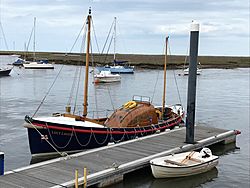RNLB Lucy Lavers (ON 832) facts for kids
class="infobox " style="float: right; clear: right; width: 315px; border-spacing: 2px; text-align: left; font-size: 90%;"
| colspan="2" style="text-align: center; font-size: 90%; line-height: 1.5em;" | 
|- | Official Number: || ON 832 |- | Donor: || |- | Station || Aldeburgh, Wells-next-the-Sea |-
|}
The RNLB Lucy Lavers (ON 832) is a famous lifeboat from the RNLI. She served at the Aldeburgh from 1940 to 1959. After that, she was part of the reserve fleet until 1968, when she retired. Today, a group called the Rescue Wooden Boats Charity is working to restore her. The Lucy Lavers is listed on the National Historic Ships register.
Contents
| History | |
|---|---|
| Owner | Royal National Lifeboat Institution (RNLI) |
| Builder | Groves & Gutteridge, Cowes, Isle of Wight |
| Laid down | 1939 |
| Acquired | 1940 |
| In service |
|
| Status | Undergoing restoration (2013) |
| General characteristics | |
| Class and type | Liverpool Class |
| Type | Motor lifeboat |
| Tonnage | Displacement of 6 tons 10cwt |
| Length | 35 ft 6 in (10.82 m) overall |
| Beam | 10 ft 3 in (3.12 m) |
| Draught | 2 ft 3.5 in (0.699 m) |
| Depth | 4 ft 4 in (1.32 m) |
| Installed power | 35hp Weyburn petrol engine |
| Speed | 7.42 kn (13.74 km/h) |
| Notes |
|
About the Lucy Lavers Lifeboat
The Lucy Lavers is a special type of lifeboat called a Liverpool-class single-engine boat. The RNLI designed these boats to have both an engine and a sail. To help her stay steady when sailing, she had a special drop keel.
Boat Design and Power
She was powered by a 35 horsepower Weyburn petrol engine. Groves and Gutteridge built her for the RNLI. Her construction started in 1939 and she was finished in 1940. She was then sent to the Aldeburgh Lifeboat Station.
Size and Weight
The lifeboat is about 35 feet 6 inches long. She is 10 feet 3 inches wide. Her draft, or how deep she sits in the water, is only 2 feet 3.5 inches. The Lucy Lavers weighs about 6 tons.
Lucy Lavers' Service in Aldeburgh
The Lucy Lavers arrived in Aldeburgh in 1940. Soon after, the Royal Navy took control of her. This also happened to Aldeburgh's other lifeboat, the RNLB Abdy Beauclerk (ON 751).
Helping at Dunkirk
The Lucy Lavers was called to Dover on May 31, 1940. She was one of 18 RNLI lifeboats needed for the Dunkirk evacuation. This was a huge effort to rescue British and French soldiers. They were stuck on the beaches of Dunkirk, France.
Small Royal Navy crews towed the lifeboats to the French coast. They arrived just east of Dunkirk harbour. The lifeboats then started to pick up soldiers. The Lucy Lavers stayed at Dunkirk, taking soldiers to bigger ships. She worked until late on June 4. Then, she and the other lifeboats returned to Ramsgate in Kent.
Wartime Rescue Missions
During the rest of World War II, the Lucy Lavers and Abdy Beauclerk were called out often. Most of these calls were for planes that had crashed into the sea. The lifeboats spent many hours searching for survivors. Often, they only found wreckage or oil. The Aldeburgh lifeboats saved 107 lives during the war.
Retirement and Restoration Journey
The Lucy Lavers served at Aldeburgh for 19 years. During this time, she helped in 30 operations and saved 7 lives. She then joined the RNLI’s reserve fleet. She served at Wells-next-the-Sea, Sheringham, and Rhyl. In this role, she completed 52 more missions and saved 37 lives.
New Roles After RNLI Service
In 1968, the RNLI sold her. She then became a pilot boat in Saint Helier, Jersey. She was renamed L’esperance. Later, she became a private fishing boat. In 1986, a Dive and Ski Club bought her. She spent most of her time around the island of Sark.
In 1997, she was finally retired from active use. Her engine cover and some parts were removed. These parts were used to help restore another lifeboat, the Howard D (ON 797). The Lucy Lavers' wooden hull was still in good shape. She was sent to a boatyard in Sens, France. There, she joined the Dunkirk Little Ships Restoration Trust.
Bringing Lucy Lavers Back to Life
Two lifeboat fans from Norfolk searched for the Lucy Lavers for a long time. They finally found her in 2006. Now, the Lucy Lavers is being fully restored in Stiffkey, Norfolk. Most of her original mahogany hull is still there.
She is listed on the National Register of Historic Vessels. Her certificate number is 2206. In 2012, the National Lottery Heritage Fund gave a grant of £99,300. This money helped the Rescue Wooden Boats charity restore the Lucy Lavers. The plan was to finish the restoration by May 2015. This would allow her to return to Dunkirk for the 75th anniversary of the evacuation. The restoration is now complete. You can see her moored at Wells Next The Sea in Norfolk.
Gallery
- RNLB Lucy Lavers (ON 832)








